For the course Introduction to Marketing, from the University of Edinburgh, from which I received a verified certificate in July 2021, I analyzed the potential benefits of a franchise as part of an assignment in Week 6: Delivering value and reaping the rewards.
I wrote this post in July to document my assignment.

Instructions
The aim of the report is to make recommendations on whether or not to enter a franchising agreement with the selected firm.
Your report should be structured as follows:
- Executive summary – Introduce the report aim as well as summary of your research.
- Advantages of franchise – List benefits deriving from franchising agreements.
- Disadvantages of franchise – Identify challenges related to franchise.
- Recommendations – Make recommendation whether it is beneficial to enter franchising agreement or not.
The instructions also specified the report should be 1 page. I went over the limit by writing 2 pages, which I don’t necessarily think is a good thing. Succinct writing has its place. Perhaps I should’ve spent more time editing. On the other hand, I did find enough interesting information to fill 2 pages. So, here is my report.
Executive Summary
This short report evaluates and recommends whether beginning a franchise opportunity with Century 21, a real estate franchisor, is a beneficial investment.
In summary, only the most experienced, well-researched, and well-funded potential franchisees should consider a franchise agreement; only those already working in real estate with a successful business of their own should consider, as the risk and costs can be quite high.
Introduction
From their website, Century 21 (C21) claims to enhance your existing “entrepreneurial spirit” with:
- Global Exposure
- Comprehensive Training
- In-Market Support
- #bestinclass Marketing
- The Scale and Buying Power of a Global Partner
Here is an examination of a few of these enhancements:
Advantages
- Comprehensive Training: C21 offers their 3-4 day “International Leadership Academy (ILA) Program”, at or near their HQ in New Jersey, USA, or another location of their choice. C21 will continue to offer continuing training opportunities in the form of written materials, email, consultation, or other means. They may also hold networking events or other educational opportunities.
- Global Exposure: The C21 website says they operate in 80 countries and territories.
- #bestinclass Marketing: This appears to refer to the use of C21 branding materials as well as working with their real estate -focused, marketing affiliates, such as advertising placements on real estate websites (“Homes.com”, “realtor.com”, etc). They also have a customer relationship management system and access to a PR studio. Here is what Century 21 says about their new brand identity: With a refreshed color palate that stays true to our iconic gold and black scheme, the new identity is more modern and distinctive than ever.
- Additional Advantage: Competition. C21 will not grant another franchise location within a ¼ mile radius (402 meters) of another office.
Disadvantages
- Comprehensive Training: Training may not be free and could cost up to $2,200; additional training costs depend on the course and duration. Training must also be completed within 24 months of signing the franchise agreement. In addition, there are many sources of training related to real estate — Is the training offered by C21 high-quality or independently recognized?
- Global Exposure: It’s really up to the franchisee to open an office in these locations. Each franchise operator will need pay attention to local real estate laws — regulations and laws can very widely across countries, territories, states, cities, and other jurisdictions.
- #bestinclass Marketing: It’s not clear if access to marketing resources would be free of charge to any franchisee. Initial investment fees can be quite high for external signs ($800-$20,000), yard/open house signs ($2,000-$20,000), computer equipment and electronic data system ($5,000-$10,000), and other advertising ($0-$10,000). Ongoing use of the CRM is tentatively included, however their Lead Management System and other computer support could cost up to $5,000/year and $1,000-$2,000/year, respectively.
- Costs: There are relatively high costs and requirements involved in the franchise agreement, such as maintenance, royalties (6%), the requirement of a guaranty by the franchisee and their spouse (even if the spouse is not involved), and other fees. The franchisor is not obligated to provide financing for the franchisee, though they may choose to do so. Initial estimated fees to start an office could range between $106,000-$456,750. A franchisee may also consider the services of an attorney and/or an accountant, and may want to look into insurance, and related to remain in compliance with real estate laws and taxes. It’s not clear if these costs are standard or unusual compared to other real estate franchisors.
Neither advantage nor disadvantage
- Licenses and Regulation: Real estate is a highly regulated industry. If a franchise owner is not a licensed broker, they must retain a “responsible broker” who must comply with all applicable laws and regulations. The broker will need to go through their own training to obtain their license.
- Terms: Each franchise is offered an initial term of 10 years. There are no renewal rights, though they may extend under different terms.
Recommendation
Depending on the location, it may be worthwhile to go into a franchise agreement. Some real estate markets could offer high enough returns to offset the costs related to fees, royalties, maintenance and upfront costs. For others, there may not be enough demand, or the demand for homes may not be consistent enough to justify costs. It would be up to the franchisee to do their own research to understand the potential and return of their desired market before getting into a franchise agreement with C21. In addition, the owner should have some knowledge of the rules and laws for their geographic location, to remain in compliance with the law.
[Choosing to franchise] is an option only for the most experienced, well-funded, and well-researched franchisee, probably already involved in the real estate market and potentially already a licensed broker of many years. Others should get more experience in real estate, in their area, before entertaining a franchise option.
Sources:
https://www.century21.com/about-us/franchise
https://www.franchisedirect.com/realestatefranchises/century-21-franchise-09094/ufoc/
So, there you have it! The findings are that franchising can be a good idea if you’re already experienced, know your market, and have the money to invest (or lose). But for new brokers, it not might be worth the investment until they’ve gained more experience.
Thoughts about the exercise
This was an interesting exercise. I liked the structure and the positives and negatives. It wasn’t as difficult as I might have thought to learn more about this franchise option. And in the end, making a recommendation was easier than I thought; the answer seemed obvious.
A few thoughts on the course
[Nov 2021] At the time I originally wrote this post, I’m not sure I was planning to pay for the certificate. It wasn’t my first marketing course. I decided to pay for the course because the lessons I learned kept popping into my head — particularly the importance of innovation and staying differentiated from competitors. I decided to get the certificate because I felt the lessons of the course were valuable enough to justify the purchase.






 The Dynamics of Desegregation
The Dynamics of Desegregation